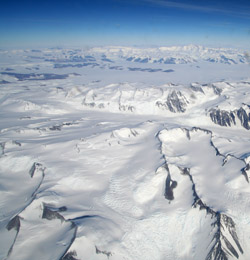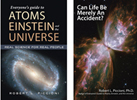Jan 18, 2011
Guide to the Cosmos Newsletter
|
|
|
World’s Largest Ice Cube and Particle Detector
|

On December 19th, 2010, construction was
completed on the IceCube Neutrino Observatory in Antarctica. A cube of
Antarctic ice one kilometer (ten football fields long) on each side has
been instrumented with over 5000 optical sensors to detect neutrinos
coming from outer space.
|
Neutrinos are the most elusive of all
known subatomic particles. (When we figure out what dark matter is,
neutrinos may take second place.) Fifty trillion neutrinos zip right
through each of us every second, and only one per week actually
interacts with the atoms in our bodies. A neutrino can easily pass
straight through a trillion miles of lead, with only a 10% chance of
“hitting” any of the lead atoms.
|
Neutrinos come primarily from the Sun,
but also from supernovae and other spectacular cosmic events. Because
they are almost unstoppable, we hope to use them to look where light
cannot penetrate. For example, it takes thousands of years for photons
(particles of light) to travel from our Sun’s core to its surface, as
they are continually absorbed and re-emitted. But neutrinos blast
straight through, reaching Earth in just over eight minutes. By using
neutrinos, we can monitor the Sun’s energy production in real time and
be forewarned of coming changes in the amount of sunlight we will
receive. Neutrinos will also give us an inside view of how stars
explode. Even though supernovae can be billions of times brighter in
visible light than our Sun, we believe as much as 99% of all their
explosive energy is in neutrinos. IceCube will let us see all we’ve been
missing.
Antarctic ice is well-suited to making a
neutrino detector, providing an enormous mass that is ultra
transparent. If a neutrino does hit an atom in the ice, there might be a
small flash of light that the sensors will detect from as much as 100
yards away. A high-energy neutrino may produce a trail telling us where
it came from and what its energy was. Hopefully this will add a new
dimension to our understanding of the universe.
|

IceCube was constructed by drilling 86
holes, each 1.5 miles deep, into the Antarctic plateau at the South
Pole, 800 miles south of McMurdo Station near the coast. The University
of Wisconsin-Madison leads this project and developed a special 4.8
megawatt hot-water drill. Each completed hole was equipped with a string
of 64 sensors before being allowed to refreeze. Construction began in
2006 and operated round the clock during the short Antarctica summer,
when the Sun shines 24 hours a day.
|

IceCube is an international collaboration, but the U.S. has provided 87% of the project’s $279 million cost.
IceCube is expected to observe 100
neutrino interactions per day, and has already recorded one with over
100 trillion electron-volts of energy, seven times the highest energy
expected from the largest man-made particle accelerator, the LHC near
Geneva.
We look forward to IceCube discoveries that are really cool.
|
|
|
images from http://www.icecube.wisc.edu/info/neutrinos/
|
Regards,
Robert
www.guidetothecosmos.com
Author of "Everyone's Guide to Atoms, Einstein, and the Universe"
and "Can Life Be Merely An Accident?"

|
|
|
|
|